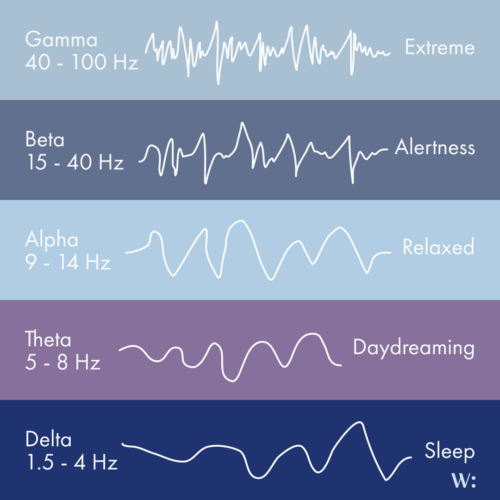Biofeedback: The science of monitoring and controlling your own body
Imagine being able to control your heart rate, brain function and muscle tension, to teach them to relax or activate certain functions. You could reduce stress, promote relaxation and so much more. This is precisely what biofeedback therapy can help you achieve.

You’re trying to meditate, but your mind won’t stop racing, your body feels tense, and the weight of stress and anxiety is overwhelming. This is where biofeedback comes in, offering insight into your body’s functions that you can’t observe on your own. With biofeedback, you can identify where and how muscle tension occurs and learn to relax. Similarly, if your heart rate is elevated during stressful situations, you can employ relaxation techniques to bring it back to a calm state.
You’ve probably heard of popular wearables like smartwatches and fitness trackers that monitor your heart rate. These devices, equipped with light sensors, can measure blood flow in your wrist, finger, or earlobe, providing a way to access biofeedback.
Using various sensors, biofeedback allows you to receive real-time feedback about your body’s physiological responses, such as heart rate and muscle tension. With this information, you can learn to control these involuntary functions, improving your physical and mental health. Now, let’s go over the most popular types of biofeedback and their benefits.
Measuring your muscle tension – Electromyography
Electromyography (EMG) is a technique used in biofeedback therapy to measure the electrical activity of your muscles. Doctors place electrodes on your skin over the muscles which you want to treat.
EMG measures the electrical impulses generated by your muscles and shows you through a visual or auditory signal how much they’re being activated. It can be done in clinics or at home with portable devices that come with sensors to measure your muscle electrical activity. These devices provide immediate feedback so you can learn to recognise which muscle groups are tense or overactive and then practice relaxation techniques to reduce muscle tension.
With regular practice, you can learn to control your muscle tension and relax your muscles on command. This can have many benefits, such as reducing stress and anxiety, improving sleep, and reducing pain and discomfort associated with muscle tension.
"EMG biofeedback enables you to measure and control your muscle activity, promoting relaxation and alleviating stress and discomfort."
Measuring your brain wave activity – Neurofeedback
This type of feedback literally teaches you to self-control your brain functions. Electrodes are placed on your scalp to measure your brain waves. Brain waves represent how your brain works and which areas of it are activated.
Your different brain wave frequencies are associated with different states of consciousness or mental activities. There are delta waves which are associated with deep sleep, theta waves associated with a relaxed or meditative state, alpha waves associated with a state of wakeful relaxation, beta waves are associated with alertness and focused concentration and gamma waves are associated with higher cognitive functions like problem-solving.
Neurofeedback measures the electrical activity of the brain and categorises the different frequencies into the delta, theta, alpha, beta, and gamma waves.
So how will you learn to control your brain functions? For example, if you’re experiencing anxiety and your neurofeedback shows an excess of beta waves, you might be taught techniques to increase alpha waves and decrease beta waves, which could help to reduce your anxiety levels.
Not only can it be useful for anxiety, but neurofeedback is also being explored as a treatment for ADHD and to help treat depression.
"Neurofeedback helps you become more aware of your brain function and teaches you to funnel your brain into the pleasant states you want."

You may also like:
Measuring your heart rate – Photoplethysmography
Photoplethysmography (PPG) monitors changes in blood volume beneath the skin using light sensors. It can be used to measure the changes in the time between your heartbeats, which is called heart rate variability (HRV).
This kind of therapy uses low-intensity infrared light because it can penetrate through the skin and interact with the blood vessels beneath it. This is why PPG sensors are often placed on the skin over a blood vessel, such as the wrist or finger, to measure the changes in blood flow and heart rate.
When you use PPG you can monitor your body functions and easily determine whether your heart rate is elevated or lowered. This awareness is very helpful since you can, on your own, take steps to regulate your heart rate. Additionally, PPG can help in the early detection of cardiovascular diseases and has the potential to be useful for asthma treatment.
"PPG biofeedback uses light sensors to monitor your heart rate, empowering you to proactively maintain cardiovascular health and detect potential risks."
Benefits of biofeedback
Biofeedback can also monitor your brain activity during meditation, providing valuable information you can save and track over time. By having access to this data on your computer or phone, you can learn to manage stress more effectively, becoming aware when your mind is in a state of calmness or overactivity.
Just like with your brain, biofeedback can monitor your breathing with sensors on your waist to measure your breathing patterns, provide feedback on your responses and teach you techniques to control them. This is where wearables are pretty useful. They can measure your heart rate and guide you through breathing exercises. Some can even alert you throughout the day to take breaks and do some breathing exercises to relax.
Overall biofeedback through wearable devices such as smartwatches, can provide you with great awareness. With easy accessibility and real-time information at your fingertips, you can understand your body’s signals empowering you to take control of your emotional well-being.
In summary, these are the benefits of biofeedback from studies:
- Reducing the levels of stress and anxiety
- Potential to help treat depression
- Treatment for asthma
- Lowering blood pressure
- Potential for treating ADHD
- Improving sleep quality
- Long and short-term pain management
So, if you’re looking for a natural and non-invasive way to improve your health and quality of life, biofeedback may be just what you need.
More from the magazine
Selected stories from our Team








